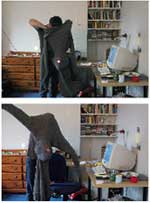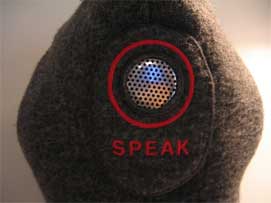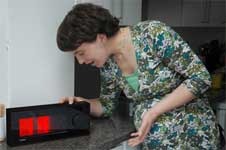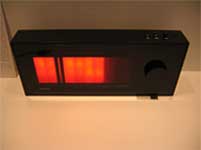Ten days ago, the Design for technology addicts post generated a lot of attention. The project was sometimes taken out of context and therefore misunderstood. As i felt guilty to have contributed to the "computer hood hysteria" i asked Joe Malia if he could send me a statement to clear this up. I'll just quote Joe:
"The computer hood is one object in a series that plays a small role in the 'Design for the Computer Obsessive' project but has really dominated the whole thing.
I wanted to characterise the behaviour of people engrossed in computer bound activities by illustrating it through the functionality of an object. The computer hood facilitates an amplified engagement between user and the computer, secluding them in a digital enclosure where the outside world is a memory and attention undivided. Those enjoying this hooded sanctity can relegate communicative interactions with the outside world to nothing more than an 'on demand' service. People outside are encouraged to 'SPEAK' towards a marked area on the back of the hood. Anything they say will be recorded and saved as an mp3 audio file on the computer desktop for perusal at the computer users leisure.


The project stemmed from an interest in the often turbulent relationship between people and technology. I began considering a series of questions. Can these relationships sometimes become dysfunctional and get out of hand? Can people become obsessed with, or even addicted to a technology?
Particularly now with the Internet and online social software, people can exist in a virtual world where they have complete control over the way they live and present themselves - would this ever appear more appealing than the responsibilities faced in modern life and would people ever neglect real world relationships in favour of virtual ones.
I felt it was important to develop a product that isn't necessarily a solution to but serves to highlight the issues addressed, (...) it is intended to be a visual metaphor to cause a debate on the subject. Through the object, interactions with the computer are reinforced but those with the real world are relegated to a very low priority or blocked out altogether. I hope people look at it a ask themselves is that me sometimes?
There were a series of other objects in the 'Design for the Computer obsessive' project that addressed issues of how might support be provided for the family living outside the computer hood. Also can design play a role in easing the transition from a life dominated by digital relational transitions towards one where human experience and relationships in the 'real world' are encouraged.
Design for the computer obsessive was not about privacy. The 'Private public' was a completely different project that was easy to group with the other work as it had a similar aesthetic. It was easy to make assumptions about but is widely being misunderstood. The images were the product, not the objects they depict - they were just props. Mobile telecommunications allow people to communicate in an incredibly intimate way about very personal things in the public domain, next to people at the bus stop, or in the park. These are not products that I think people should have, quite the opposite they are physical representations of boundaries we don't have."
So what's the Computer Hood like exactly? It is completely soundproof and black lycra lining in the tunnel blocks out the light as well. Latex grips hold it to the monitor. A retractable USB cable can be pulled from the front and plugged into the computer allowing sound to travel to speakers embedded in the hood. A voice activated microphone is embedded in the back of the head that records audio from the outside world and saves it as mp3 files in a folder on the desktop. A zip on the underside of the tunnel can be opened so you can see the keyboard/mouse.
Now more about the other objects in the Design for the Computer Obsessive project:


The families of compulsive computer users are often left to struggle alone with the emotional fallout of the affliction. Support Radio, developed with Daniel Goddemeyer, is a support network that facilitates communication between family members estranged by the technology. It allows them to share experiences and offer encouragement in a cathartic audio forum.
[....]

